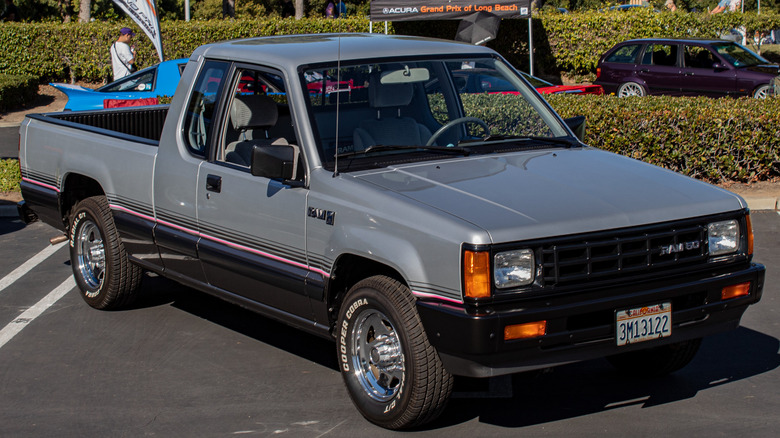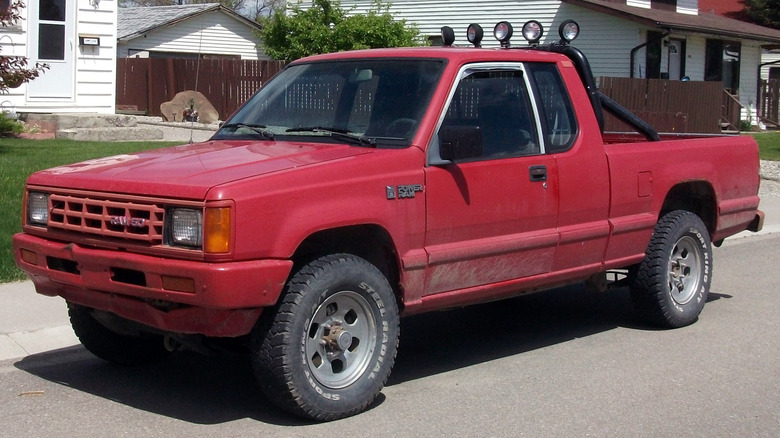The Classic Ram Mini-Truck We Wish Dodge Would Bring Back
Reportedly, a midsize pickup truck from Chrysler (now Stellantis) offshoot Ram has been in the advanced development phase since at least 2021. Resurrecting the Dakota nameplate would certainly be a welcome addition since Ram is the only one of the Big Three domestic truck manufacturers not to have a smallish pickup in its lineup. Apparently, history is repeating because Chrysler found itself in the same position way back in the 1970s, playing catch-up to Ford's Courier and Chevy's LUV compact pickups, both unveiled in 1972.
Dodge finally joined the party in 1979 with the D-50, later renamed the Ram 50. At the time, Chrysler's financial strength was questionable and its engineering teams were tied up in developing the K-car platform and minivans that would eventually rescue the company. As such, the tried and true formula of importing and rebadging a Japanese truck — called a captive import — was employed. In the case of the D-50, it was a rebadged Mitsubishi Triton (a.k.a., Forte and L200), which made sense because Dodge was already rebranding another Mitsubishi as its Colt compact car.
In its inaugural year of 1979, the D-50 (and its short-lived sibling, the Plymouth Arrow), was propelled by a 2.0-liter four-cylinder with 93 horsepower or a 2.6-liter four-cylinder good for 105 horsepower in the sport model. A four-speed manual transmission was standard, with an available five-speed manual, as well as an optional automatic transmission. Like other mini trucks, the cargo bed measured a generous 72 inches, with the later option for an 88-inch bed.
[Featured image by LukaCali via Wikimedia Commons | Cropped and scaled | CC BY-SA 4.0]
The Ram 50 soldiered on even after the Dakota was ready
The year 1981 proved significant for the little D-50, which was renamed the Ram 50. That same year, a four-wheel drive version was introduced, called the Power Ram 50. The Ram 50 received some unwelcome competition in 1982 when Mitsubishi itself decided to sell vehicles directly to the American market and wouldn't you know, one of its first products was the "Mighty Max" pickup, a virtual twin to the Ram 50. To differentiate the two trucks, Dodge gave the Ram a mild facelift with quad headlights for 1983, versus the Mitsubishi's two single headlights. Besides a new fascia, 1983 also introduced a new but somewhat underwhelming turbocharged diesel powerplant.
When Dodge unveiled a midsize pickup of its own design called the Dakota in 1987, many automotive insiders thought that might spell the end for the Ram 50, but quite the opposite happened. Smaller than the new Dakota and apparently worth keeping in the product lineup, the Ram 50 was completely restyled with new chunky, muscular lines. In 1988, an extended cab ("sports cab" in Dodge speak) was made available, with additional storage space or small jump seats behind the front seats, and in 1990, an optional V6 engine was introduced, producing a respectable 142 horsepower.
Following a longer production run than many thought possible, the Ram 50 was finally axed after 1993. Some enthusiasts speculate that the cancelation had more to do with Chrysler's independence from relying on Mitsubishi than an overlap in product between the full-size, midsize, and compact trucks. Nowadays, even a single choice more diminutive than the Ram 1500 sounds like a recipe for success.
[Featured image by dave_7 from Lethbridge, Canada via Wikimedia Commons | Cropped and scaled | CC BY 2.0]

